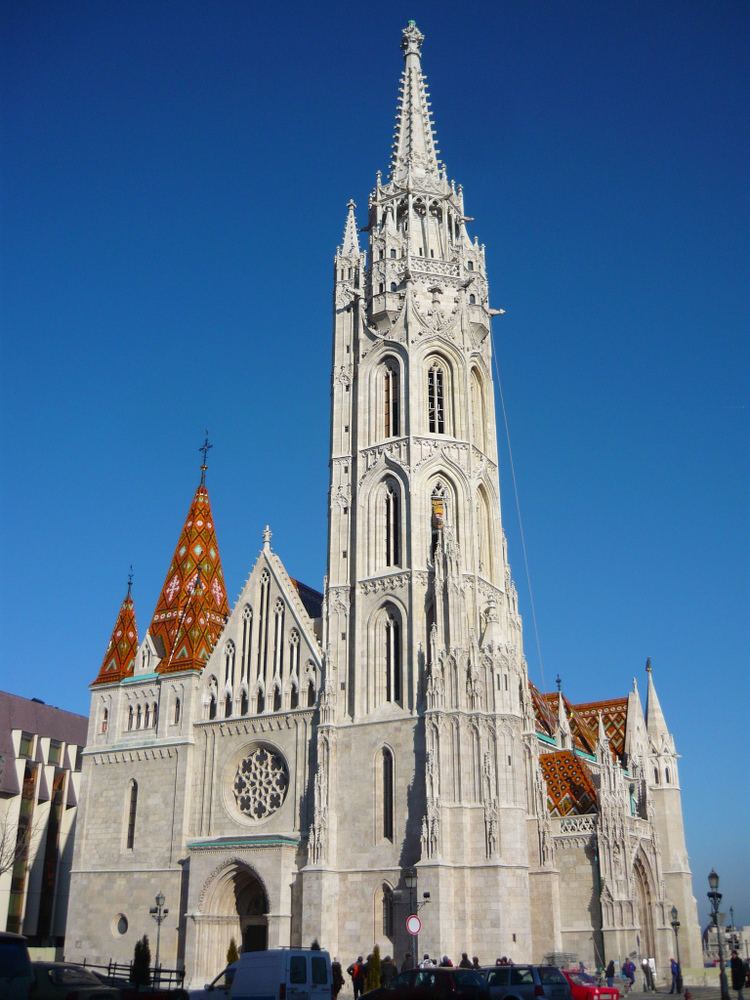Location Budapest Denomination Roman Catholic Founded 11th century Phone +36 1 355 5657 | Country Hungary Website www.matyas-templom.hu Height 80 m Architect Frigyes Schulek | |
 | ||
Founder(s) Saint Stephen of Hungary Address Budapest, Szentháromság tér 2, 1014 Hungary Architectural styles Gothic Revival architecture, Gothic architecture Similar Fisherman's Bastion, Buda Castle, Chain Bridge, Hősök tere, St Stephen's Basilica | ||
Budapest st matthias church
Matthias Church (Hungarian: Mátyás-templom) is a Roman Catholic church located in Budapest, Hungary, in front of the Fisherman's Bastion at the heart of Buda's Castle District. According to church tradition, it was originally built in Romanesque style in 1015, although no archaeological remains exist. The current building was constructed in the florid late Gothic style in the second half of the 14th century and was extensively restored in the late 19th century. It was the second largest church of medieval Buda and the seventh largest church of the medieval Hungarian Kingdom.
Contents
History
The first church on the site was founded by Saint Stephen, King of Hungary in 1015. This building was destroyed in 1241 by the Mongols; the current building was constructed in the latter half of the 13th century. Originally named after the Virgin Mary, taking names such as "The Church of Mary" and "The Church of Our Lady," Matthias Church was named after King Matthias in the 19th Century, who ordered the transformation of its original southern tower.
The church was the scene of several coronations, including that of Charles IV in 1916 (the last Habsburg king). It was also the site for King Matthias's two weddings (the first to Catherine of Poděbrady and, after her death, to Beatrice of Naples). During the century and a half of Turkish occupation, the vast majority of its ecclesiastical treasures were shipped to Pressburg (present day Bratislava) and following the capture of Buda in 1541 the church became the city's main mosque. Ornate frescoes that previously adorned the walls of the building were whitewashed and interior furnishings stripped out.
The church was also the location of the "Mary-wonder." In 1686 during the siege of Buda by the Holy League a wall of the church collapsed due to cannon fire. It turned out that an old votive Madonna statue was hidden behind the wall. As the sculpture of the Virgin Mary appeared before the praying Muslims, the morale of the garrison collapsed and the city fell on the same day.
Although following Turkish expulsion in 1686 an attempt was made to restore the church in the Baroque style, historical evidence shows that the work was largely unsatisfactory. It was not until the great architectural boom towards the end of the 19th century that the building regained much of its former splendour. The architect responsible for this work undertaken in 1873-96 was Frigyes Schulek.
The church was restored to its original 13th-century plan, but a number of early original Gothic elements were uncovered. By also adding new motifs of his own (such as the diamond pattern roof tiles and gargoyles laden spire) Schulek ensured that the work, when finished, would be highly controversial.
The church was the venue for the coronation of the last two Hungarian Habsburg kings, Franz Joseph in 1867 and Charles IV in 1916.
In 1990, The Texas A&M Singing Cadets performed here during one of their highly acclaimed international tours [2].
During World War II the church was badly damaged. Matthias Church was used as a camp by the Germans and Soviets in 1944–45 during the Soviet occupation of Hungary. The church was largely renovated between 1950 and 1970 with funding from the Hungarian government. The bell tower was restored, along with renovation of interior paints and frescos. The five-manual organ, which had been destroyed during the war, was updated and sanctified in 1984.
A thorough restoration programme was carried out from 2006 to 2013. Half of the HUF 9.4 billion cost was met by the government.
It is home to the Ecclesiastical Art Museum, which begins in the medieval crypt and leads up to the St. Stephen Chapel. The gallery contains a number of sacred relics and medieval stone carvings, along with replicas of the Hungarian royal crown and coronation jewels.
The church bells
Today the church has 7 bells, 6 of them are located in the bell tower and the last damaged bell hangs in the cavalry tower. The tower has two historic bell and it has got 4 new bell in 2010, then the Szt. Károly bell sound correction took place.
